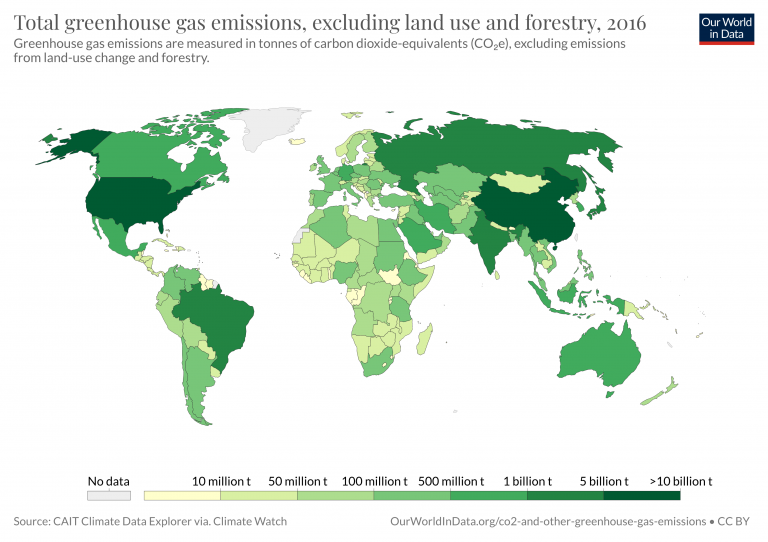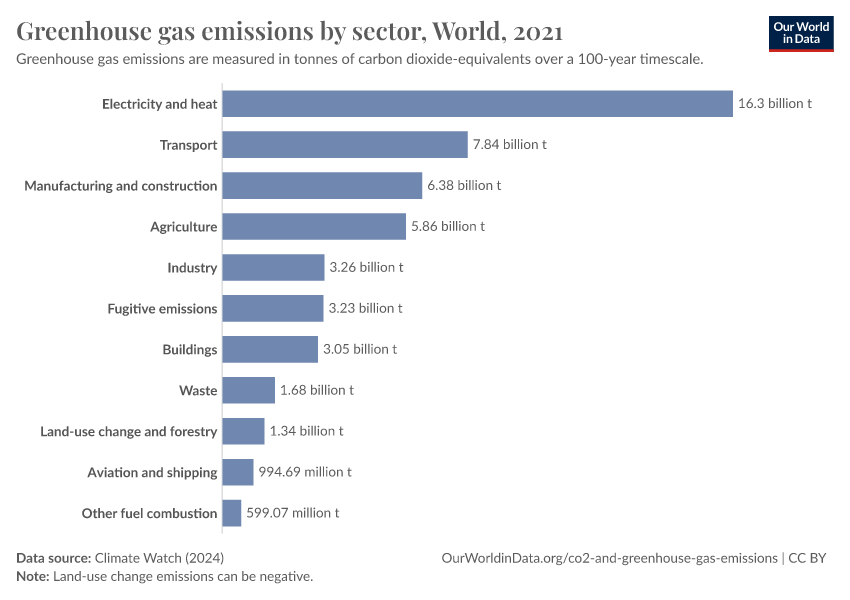You can download our complete Our World in Data CO2 and Greenhouse Gas Emissions database.
Many of us want an overview of how our country is doing in reducing CO2 and other greenhouse gas emissions. This page provides the data for your chosen country across all of the key metrics on this topic.
In the selection box above you can also add or remove additional countries and they will appear on all of the charts on this page. This allows you to compare specific countries you might be interested in, and measure progress against others.
The data will continue to update – often on an annual basis – with the latest global and country emissions estimates.
- Per capita: how much CO2 does the average person emit?
- What are the country’s annual CO2 emissions?
- Year-on-year change: what is the percentage change in CO2 emissions?
- Cumulative: how much CO2 has it produced to date?
- Consumption-based accounting: how do emissions compare when we adjust for trade?
- What share of global CO2 emissions are emitted by the country?
- What share of global cumulative CO2 has the country emitted?
Maldives: Per capita: how much CO2 does the average person emit?
Annual emissions figures are often used to compare countries’ contribution to climate change. But this metric often reflects differences in population size across the world.
To understand the ‘footprint’ of the average person in a given country, this chart shows per capita emissions.
These figures reflect ‘production-based’ emissions, so do not correct for traded goods.
Maldives: What are the country’s annual CO2 emissions?
This interactive chart shows how much carbon dioxide (CO2) is produced in a given year.
A few points to keep in mind when considering this data:
- These figures are based on ‘production’ or ‘territorial’ emissions (i.e. emissions from the burning of fossil fuels, or cement production within a country’s borders). It does not consider the emissions of traded goods (consumption-based emissions). You find consumption-based emissions later in this country profile.
- These figures look specifically at CO2 emissions – not total greenhouse gas emissions. You find total, and other greenhouse gas emissions, later in this country profile.
- Annual emissions can be largely influenced by population size – we present the per capita figures above.
Maldives: Year-on-year change: what is the percentage change in CO2 emissions?
This interactive chart shows the year-on-year growth in annual CO2 emissions.
- A positive figure indicates that the emissions in a given year were higher than the previous year.
- A negative figure indicates that emissions were lower than the previous year.
Year-to-year changes in emissions can vary a lot – this can create a particularly ‘noisy’ time series.
Maldives: Cumulative: how much CO2 has it produced to date?
When we only look at emissions produced today, we fail to recognise historical responsibility for emissions in recent decades or centuries.
This interactive chart shows cumulative CO2 emissions – the sum of emissions produced since 1751 to the given year. This allows us to understand how much of the total CO2 emissions to date has been emitted by a given country.
Maldives: Consumption-based accounting: how do emissions compare when we adjust for trade?
When countries set targets, measure or compare CO2 emissions, they tend to focus on production-based emissions – CO2 emitted within a country’s own borders. However, this fails to capture emissions from traded goods – the CO2 emitted in the production of goods elsewhere, which are later imported (or the opposite: emissions from goods that are exported).
We can estimate consumption-based CO2 emissions by correcting for trade. These emissions are shown in the interactive chart. Note that the resolution of data needed to calculate this is not available for all countries.
→ We provide more detail on consumption-based emissions in our article ‘How do CO2 emissions compare when we adjust for trade?‘
Maldives: What share of global CO2 emissions are emitted by the country?
Looking at a country’s annual emissions is useful, but it can be hard to put these numbers in context of the global total. Is 10 million tonnes of CO2 large or small; what about 100 million; or 1 billion tonnes?
This interactive chart shows annual emissions as a percentage of the global total in a given year.
Maldives: What share of global cumulative CO2 has the country emitted?
Maldives: What share of CO2 emissions are produced from different fuels?
CO2 emissions are dominated by the burning of fossil fuels for energy production, and industrial production of materials such as cement.
What is the contribution of each fuel source to the country’s CO2 emissions?
This interactive chart shows the breakdown of annual CO2 emissions by source: either coal, oil, gas, cement production or gas flaring. This breakdown is strongly influenced by the energy mix of a given country, and changes as a country shifts to or from a given energy source.
How you can interact with this chart
- In these charts it is always possible to switch to any other country in the world by choosing Change Country in the bottom left corner.
- By unticking the ‘Relative’ box, you can switch to see the breakdown of emissions in absolute terms.
Maldives: How are CO2 emissions from different fuels changing?
The chart above allows us to see the breakdown of CO2 emissions by fuel type. But it makes it more difficult to see the absolute change in particular fuel sources over time.
This interactive chart shows the same data – CO2 emissions from coal, oil, gas, cement and flaring – but as individual lines to see clearly how each is changing over time.
In discussions on climate change, we tend to focus on carbon dioxide (CO2) – the most dominant greenhouse gas produced by the burning of fossil fuels, industrial production, and land use change.
But CO2 is not the only greenhouse gas that is driving global climate change. There are a number of others – methane, nitrous oxide, and trace gases such as the group of ‘F-gases’ – which have contributed a significant amount of warming to date.
Here we look at total greenhouse gas (GHG) emissions across the world, plus breakdowns of other major gases including methane and nitrous oxide.
Maldives: Total greenhouse gas emissions: how much does the average person emit? Where do emissions come from?
The charts above focused on carbon dioxide (CO2). But CO2 is not the only greenhouse gas. Others, including methane and nitrous oxide, have also had a significant impact on global warming to date.
The first interactive chart shows per capita greenhouse gas emissions. This is measured as the sum of all greenhouse gases, and given by a metric called ‘carbon dioxide equivalents’.
‘Carbon dioxide equivalents’ try to correct for the fact that one unit (e.g. a tonne) of a given gas doesn’t have the same same impact on warming as another. We therefore multiply the emissions of each gas by its ‘global warming potential’ (GWP) value: this measures the amount of warming one tonne of that gas would create relative to one tonne of CO2.
The other interactive chart shows where these emissions come from: the contribution of each sector.
→ We provide more detail on total greenhouse gas emissions in our sub-page ‘Greenhouse gas emissions‘.
Maldives: Methane: how much does the average person emit? Where do emissions come from?
Methane (CH4) is a strong greenhouse gas, mainly produced through agricultural activities (e.g. livestock and rice production), in addition to leakages from oil and gas production (called ‘fugitive emissions’).
This first interactive chart here shows per capita emissions of methane each year. This is measured in ‘carbon dioxide equivalents’.
The other interactive chart shows where these emissions come from: the contribution of each sector.
→ We look at the breakdown of methane sources in our sub-page ‘Emissions by sector‘.
Maldives: Nitrous oxide: how much does the average person emit? Where do emissions come from?
Nitrous oxide (N2O) is a strong greenhouse gas, that is mainly produced from agricultural activities (e.g. from the use of synthetic and organic fertilizers to grow crops).
This first interactive chart here shows per capita emissions of nitrous oxide each year. This is measured in ‘carbon dioxide equivalents’.
The other interactive chart shows where these emissions come from: the contribution of each sector.
→ We look at the breakdown of nitrous oxide sources in our sub-page ‘Emissions by sector‘.
Maldives: Energy intensity: how much energy does it use per unit of GDP?
Since energy is such a large contributor to CO2, reducing energy consumption can inevitably help to reduce emissions. However, some energy consumption is essential to human wellbeing and rising living standards.
Energy intensity can therefore be a useful metric to monitor. Energy intensity measures the amount of energy consumed per unit of gross domestic product. It effectively measures how efficiently a country uses energy to produce a given amount of economic output. A lower energy intensity means it needs less energy per unit of GDP.
This interactive chart shows energy intensity.
Two tips on how you can interact with this chart
- Add any other country to this chart: click on the Edit countries and regions button to compare with any other country.
- View this data on a world map: switch to a global map of energy intensity using the ‘MAP’ tab at the bottom of the chart.
Maldives: Carbon intensity: how much carbon does it emit per unit of energy?
Energy intensity – shown in the chart above – is one important metric to monitor whether countries are making progress in reducing emissions. The other key part of this equation is carbon intensity: the amount of CO2 emitted per unit of energy.
We can reduce emissions by (1) using less energy; and/or (2) using lower-carbon energy.
This metric monitors the second option. As we transition our energy mix towards lower-carbon sources (such as renewables or nuclear energy), the amount of carbon we emit per unit of energy should fall.
This chart shows carbon intensity – measured in kilograms of CO2 emitted per kilogram of oil equivalent consumed.
Maldives: Has economic growth decoupled from CO2 emissions?
To reduce emissions and achieve increasing prosperity at the same time, we have to decouple economic growth from CO2 emissions. Several countries have achieved this in recent years.
The chart here shows whether this country has achieved this by showing the change in GDP per capita, and annual per capita CO2 emissions over time.
We show both production-based and consumption-based emissions (for countries where this data is available). This allows us to see whether the import of production from other countries – or the export to other countries – has affected this change in emissions.
The next chart shows the same metric, but without adjusting for population. It shows the change in total annual CO2 emissions and GDP.



















